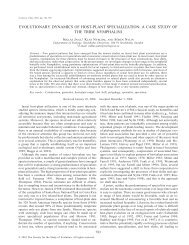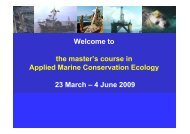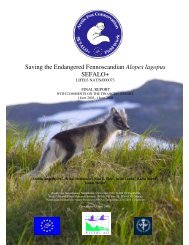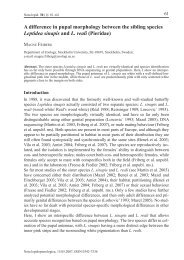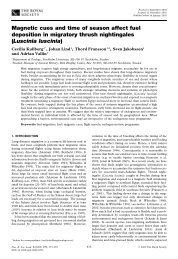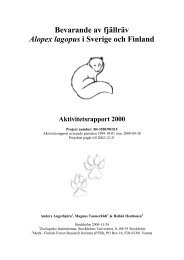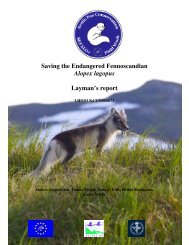The conservation of Fennoscandian arctic foxes - Stockholms ...
The conservation of Fennoscandian arctic foxes - Stockholms ...
The conservation of Fennoscandian arctic foxes - Stockholms ...
You also want an ePaper? Increase the reach of your titles
YUMPU automatically turns print PDFs into web optimized ePapers that Google loves.
INTRODUCTION<strong>The</strong> <strong>arctic</strong> fox (Alopex lagopus) in Fennoscandia is threatened to go extinct and is considered a priorityspecies according to the EC Habitat directive. <strong>The</strong> <strong>Fennoscandian</strong> <strong>arctic</strong> fox mainly relies on voles andlemmings as a food resource (Elmhagen, Tannerfeldt & Angerbjörn, 2002) and its populationdynamics is therefore highly correlated to the rodent population cycles (Figure 1.). During the mid-19 thcentury, the Swedish population size approximated 4700 individuals during lemming peakyears(Tannerfeldt, 1997). However, as trading with <strong>arctic</strong> fox fur became pr<strong>of</strong>itable in the end <strong>of</strong> the19 th century, human hunting pressure was intensified and the population drastically declined to a fewhundred individuals (Zetterberg, 1945). <strong>The</strong> <strong>arctic</strong> fox has been protected by law since 1928 inSweden, 1940 in Finland and 1930 in Norway, but their numbers has still not increased and thesituation deteriorated during the 1980s and 1990s due to absence <strong>of</strong> lemming peaks (Gärdenfors, 2005;Hersteinsson et al., 1989; Kålås, Viken & Bakken, 2006). Today, there are approximately 120 adult<strong>arctic</strong> <strong>foxes</strong> in Fennoscandia, <strong>of</strong> which approximately 50 are found in Sweden, 50 in Norway, and lessthan 10 in Finland (Angerbjörn, Hersteinsson & Tannerfeldt, 2004; Kaikusalo, 2000; Linnell, 1999b).Due to the species capacity for extensive migrations, the <strong>arctic</strong> fox in Sweden, Finland and Norwaywas previously regarded as a single population (Hersteinsson et al., 1989). However, according togenetic analyses, these are fragmented into four isolated areas with no gene flow in between (Dalén etal., 2006). Each <strong>of</strong> these areas is inhabited <strong>of</strong> about 10-50 individuals each and, accordingly, the risk<strong>of</strong> negative effects directly or indirectly related to the low population size is substantial (Dalén et al.,2006).<strong>The</strong>re are several factors influencing the non-recovery <strong>of</strong> the <strong>Fennoscandian</strong> <strong>arctic</strong> fox, <strong>of</strong> which thesmall population size constrained by low food availability in combination with inter-specificinteractions with red <strong>foxes</strong> (Vulpes vulpes) is considered the most prominent ones (Angerbjörn et al.,2004). Due to the high degree <strong>of</strong> specialization in utilizing rodents as food resource, the number <strong>of</strong><strong>arctic</strong> <strong>foxes</strong> is dependent on the density phase <strong>of</strong> the rodent cycle and the population numbers candiffer drastically between good and bad rodent years (Angerbjörn et al., 1995). <strong>The</strong> species has thelargest litter size <strong>of</strong> all carnivores, with capacity <strong>of</strong> raising as much as 19 cubs during years with highfood availability (Angerbjörn et al., 2004). When rodent availability is high, the population sizeincreases rapidly, but is typically followed by a crash one or two years later due to decreasing rodentdensity (Tannerfeldt & Angerbjörn, 1998). In Fennoscandia, these population cycles are in generalrepeated with a four years interval and, thus, each time the rodent cycle crashes, the <strong>arctic</strong> foxpopulation collapses to extremely low numbers. On a yearly basis, juvenile mortality rate due tostarvation and predation can reach 90% whereas the adult mortality rate is about 50% (Tannerfeldt,Angerbjorn & Arvidson, 1994). <strong>The</strong> <strong>arctic</strong> fox also depends on remains <strong>of</strong> carrion left by largerpredators such as the wolf and the wolverine(Elmhagen & Rushton, 2007; Hersteinsson et al., 1989;Tannerfeldt, Elmhagen & Angerbjörn, 2002). Present low numbers <strong>of</strong> these predators may havereduced the amount <strong>of</strong> available winter food for <strong>arctic</strong> fox. Global warming is also assumed to affectthe climate in northern Fennoscandia through decreased snow cover, increased growing season andincreased primary productivity (Moen et al., 2004).Moreover, the red fox is currently increasing its range above the tree line and threatens the <strong>arctic</strong> foxby competition for resources (Tannerfeldt et al., 2002)and intra-guild predation (Hersteinsson et al.,1989). Basically, the <strong>arctic</strong> fox and the red fox have the same fundamental food niche (Frafjord, 2000),although red fox is a generalist to a higher extent and can thus switch to alternative prey like birdswhen rodent density is low (Elmhagen et al., 2002). Furthermore, the <strong>arctic</strong> fox and the red fox havesimilar habitat preferences and the dominant red fox can thus exclude <strong>arctic</strong> <strong>foxes</strong> from their breedingrange by taking over dens. Regarding intra-guild predations, there are two possible effects <strong>of</strong> whichthe first conveys in a direct killing which causes a direct demographic effect. A possible effect <strong>of</strong>global warming is an increasing primary productivity and prey availability on the mountain tundra,which may benefit the red fox. This would cause an increased competition and predation <strong>of</strong> red fox onthe <strong>arctic</strong> fox with a predicted decrease in juvenile and adult survival as well as a lowered number <strong>of</strong>breeding attempts would be expected. Alternatively, killing might take place but only relatively rarely3



